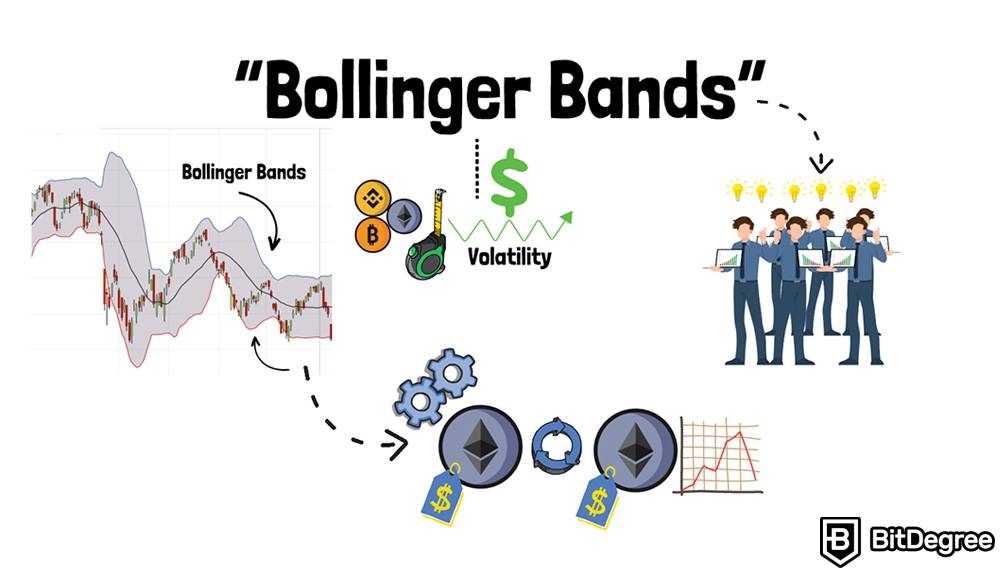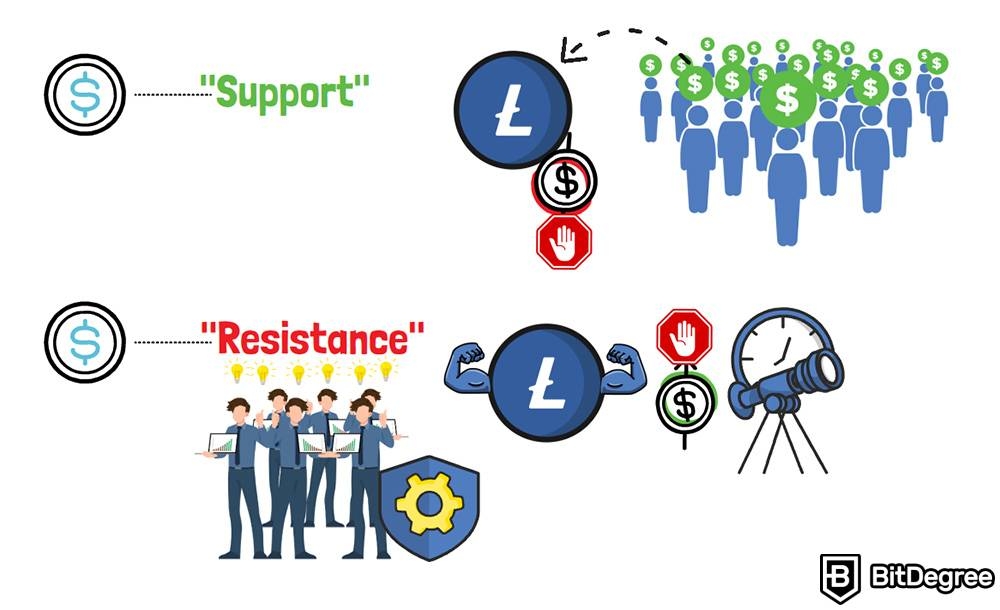8.2 Crypto Technical Analysis Indicators You Must Know About
Stop overpaying - start transferring money with Ogvio. Sign up, invite friends & grab Rewards now! 🎁
In this section, I’m going to talk about the best technical analysis indicators for crypto!
You cannot overestimate the importance of this subject. Many crypto newcomers think they can learn crypto trading by simply participating in the market, and gathering experience along the way. But the best technical analysis indicators for a trader are like a map for a traveler - they can show you the way.
These indicators can get quite perplexing. Sometimes, the way they’re called is enough to scare eager learners away. But, as always, that’s what I’m here for, to turn “complex” into “simple”.
In this section, we’re going to talk about what are the best technical analysis indicators for crypto, what’s their purpose, and why it’s important to be aware of them. As usual, I’ll explain them one by one, and provide examples from the crypto world. As you’ll see towards the end of the section, these sophisticated terms will no longer look as inaccessible as they may have in the past!
Let’s dive straight into it!

Video Explainer
Video Explainer: Crypto Technical Analysis Indicators You Must Know About
Reading is not your thing? Watch the "Crypto Technical Analysis Indicators You Must Know About" video explainer
Best Crypto Analysis Indicators Explained (Beginner-Friendly Animation)


Moving Average (MA)
So, let’s begin by taking a look at something that’s known as “Moving Average.” It’s a substantial technical analysis indicator that every serious crypto trader is well aware of.

Moving average, or “MA”, is a technical indicator that helps traders spot price trends. Thanks to it, traders can prepare to buy or sell select assets in advance.
The moving average is calculated by adding up the recent prices of a particular asset, and then dividing that figure by the number of time periods in the calculation average.
Here’s what I mean by that. A crypto asset’s price is averaged over a certain time period. Most commonly, these time periods range from 20, 50 or 200 days. For example, a 50-day moving average is calculated by adding up 50 closing prices of a particular coin or token from the last 50 days, and then dividing that number by 50.
Thanks to this indicator, traders can see in what direction the trend is heading.
So, after calculating the result, and portraying it in a visual way, this indicator allows traders to see through short-term price fluctuations, making it easier to understand the possible long-term price direction of an asset. It’s also why MA is considered one of the best technical analysis indicators for crypto.
If the price is consistently above its moving average, it is considered to be in an uptrend, and if it is consistently below, it is considered to be in a downtrend.
Of course, one could only wish that moving averages were the solution to the risks of trading crypto. Other indicators, factors, and circumstances should always be taken into account, as well.
That said, let’s take a look at yet another option for the best technical analysis indicators for crypto.
Relative Strength Index (RSI)
Specifically, “Relative Strength Index”, or “RSI.” It helps traders understand if a cryptocurrency is overbought, meaning it has been bought too much due to the coin’s price drop, or oversold, meaning it’s been sold too much because it increased in price.

Let’s simplify this. The RSI is expressed on a scale from 0 to 100, and is usually measured over a specific time frame, typically 14 days. When its score is above 70, it means the currency is overbought. And if a currency is overbought, it sends a signal that its price may go down in the near future.
Now, when the RSI score is below 30, it’s considered to be oversold. This sends an opposite signal that its price can increase soon.
So, basically, this tool is like a life hack that allows traders to take a sneak peek into the market’s future. Of course, once again, other factors and influences play an important role as well, and RSI should never be used in isolation, since it can result in uninformed trading decisions.
Bollinger Bands
Moving on, let’s take a look at “Bollinger Bands.” Even though the name is very unclear, this technical indicator makes things far clearer for traders.

It’s used to measure the volatility in the price of a particular cryptocurrency. It achieves this by creating a visual representation of how much a crypto asset’s price has drifted away from the average.
Once again, it allows traders to predict whether the coin is being overbought, or oversold. Just like with the “Relative Strength Index,” this allows them to take an informed guess about whether the price is about to go up or down.
Here’s how Bollinger Bands are used in practice. This index is expressed in two bands on a price chart - the upper one, and the lower one.
When the crypto coin’s price rises and reaches (or breaks through) the upper band, it can be read as a signal that a price reversal is on its way - in other words, that it can go down soon. Traders can use this information as a hint that selling their holdings right now could be the right thing to do.
When the price reaches the lower band, it can be understood as a signal to do the exact opposite - to buy the tokens, since their price may increase any day, or any minute, from now.
Ichimoku Cloud
Now, let’s take a look at something that at least sounds less technical. I’m talking about the “Ichimoku Cloud.” This poetic-sounding indicator is a powerful tool in the hands of those who know how to use it correctly.

Similarly to other crypto indicators, the Ichimoku Cloud helps traders identify potential trend reversals, plan their investment actions ahead, and scan the overall market sentiment. It’s called a “cloud,” because it resembles one, when visualized on a price chart.
This cloud is made up of two lines. Line A and Line B. Respectively, they represent the average of the highest high and lowest low of a particular crypto coin over a specific period of time.
Now, once traders take a look at the cloud, they can see what the coin’s price is up to. When the price is above the cloud, traders can interpret it as a bullish signal. Specifically, it sends a signal that the price is up. When the price is below the cloud, traders read it as a bearish signal - there’s a downwards trend.
This helps them understand how the coin is going to perform in the upcoming days, thus informing them about whether it’s the right time to buy or sell.
By the way, if you want to learn more about what “bullish” and “bearish” signals are, you should check out the section dedicated to this topic!
Overall, this indicator is a powerful source of insights for traders. But, just like with any other indicator - it should not be relied upon entirely, since the crypto market is way too versatile and complex.
Fibonacci Retracement
Now, as the cherry on top, let’s address something that sounds the most fun. Everyone’s heard of the Fibonacci Sequence. Found everywhere, from Baroque paintings to memes, this “Fibonacci” has its practical application in crypto, as well. But, in crypto, it’s called the “Fibonacci Retracement.”

It’s a technical analysis tool used by traders to predict an asset's price movement. It is based on the famous Fibonacci sequence, the satisfying mathematical concept in which each number is the sum of the two preceding numbers, and, when expressed visually, becomes recognizable because of its universal application in measuring visual symmetry.
In the context of crypto, Fibonacci retracement is used to identify potential price levels, and their trends.
This is how it’s used in practice. First, a trader has to identify the high and low points of the cryptocurrency's price movement over a fixed period of time. Then, they would draw horizontal lines through these points to create a "retracement grid" on the chart. Having done that, the trader has established the possible price levels that may act as areas of support or resistance for the price.
Now, what are these areas of “support” and “resistance” in crypto?
These concepts are used to identify the potential price levels that may play a key role in changing how the market reacts to a particular coin or token. When an asset reaches a particular price, if it’s low - it’s called the support, if it’s high - it’s called resistance.

When a price reaches its support level, the demand for this asset can get strong, which would stop the asset’s price from falling down further.
When a price reaches its resistance level, traders understand that the cryptocurrency is performing strong enough, and it becomes safer to assume that its price will not continue increasing in the nearest future. So, when traders observe price movements, they follow support and resistance levels to catch signals about new buying and selling opportunities.
In short, the Fibonacci Retracement allows traders to look for a pattern between the support and resistance levels.
For instance, a trader may look at the Fibonacci retracement levels as potential places of support where the price may begin its rebound, and start heading back up. And if a cryptocurrency is in an uptrend, this tool gives a hint about when its price may start declining. It’s yet another smart life-hack that allows traders to try and predict the future of the highly volatile crypto market.
Wrapping Up
There are many lists of the best technical analysis indicators for crypto. In this section, I’ve covered 5 of these tools. Every advanced trader is well aware of them, and employs them on a daily basis.
The debate about which indicator is the best one is dubious. On the one hand, many people have their preferences. On the other hand, it’s safe to say that relying on a single analysis indicator is not only insufficient, but it’s dangerous, stupid even.
The crypto market is in perpetual motion, and it’s impossible to find a solution for all the problems that traders run into every day. Therefore, the best approach is to educate oneself, understand the importance of technical analysis indicators, and find which ones are the best for you.










